
USI 2017: The Talks You Should Watch

Every year, the French company Octo organizes USI, a two day conference for IT and executive managers to discover new trends, new inspirations, and new influencers. It’s a huge even with more than 1,800 attendants, and it takes place in the Louvre, in Paris. The 2017 edition was just like the previous ones - a series of TED talks extended to 40 minutes each, by international level speakers. I attended the entire conference, and here is what I saw.
The shows that you must watch
- Ready for change, by Aaron Dignan (Change Management, Leadership)
- Free Beer and Other Secrets of Human Motivation, bv Dan Ariely (Change Management, Leadership)
- Einstein ou l’art de dépasser les limites du monde, by Etienne Klein (Philosophy, Innovation) (French)
- Redesigning Leadership, by John Maeda (Leadership, Design)
- La peur, by Ingrid Betancourt (Greater Good) (French)
The talks that you should watch if you’re new to the field
- Megatrends, by Mark Esposito (Prospective, Innovation, Greater Good)
- Beyond Budgeting, by Bjarte Bogsnes (Management, Agile)
- The Future of Machine Intelligence, by Nick Bostrom (Prospective, AI)
- Hack the Future, by Keren Elazary (Security)
- Agile: Where Are We At?, by Henrik Kniberg (Agile)
The talks you can watch online if you have time
- Accelerate digital transformation, by Eddie Obeng (Innovation)
- Give Work, by Leila Janah (Greater Good)
- The simulated world our brain generates for us, by Moran Cerf (Prospective, Cybernetics)
- Procrastination, by Tim Urban (Management)
There were several tracks in parallel, so I couldn’t cover all talks. Speakers Cedric de Villani, Ash Maurya, or Kevin Kelly were there, too.
Udpate: I’ve added links to the videos of the conference now that they are on YouTube.
X might track you and we would rather have your consent before loading this tweet.
Beyond Budgeting, by Bjarte Bogsnes
Categories: Management, Agile
My take: A very quick introduction to the Beyond Budgeting framework, which proposes an alternative way of managing people based on current common sense business trends (agile, holacracy, etc). Clearly explained - although it could have been a bit longer. I like the direction that this framework takes, but I can’t find anything to use right away at marmelab because we’re already applying much of it - just not calling these practices the same. The talk made me want to learn a bit more about the framework though.
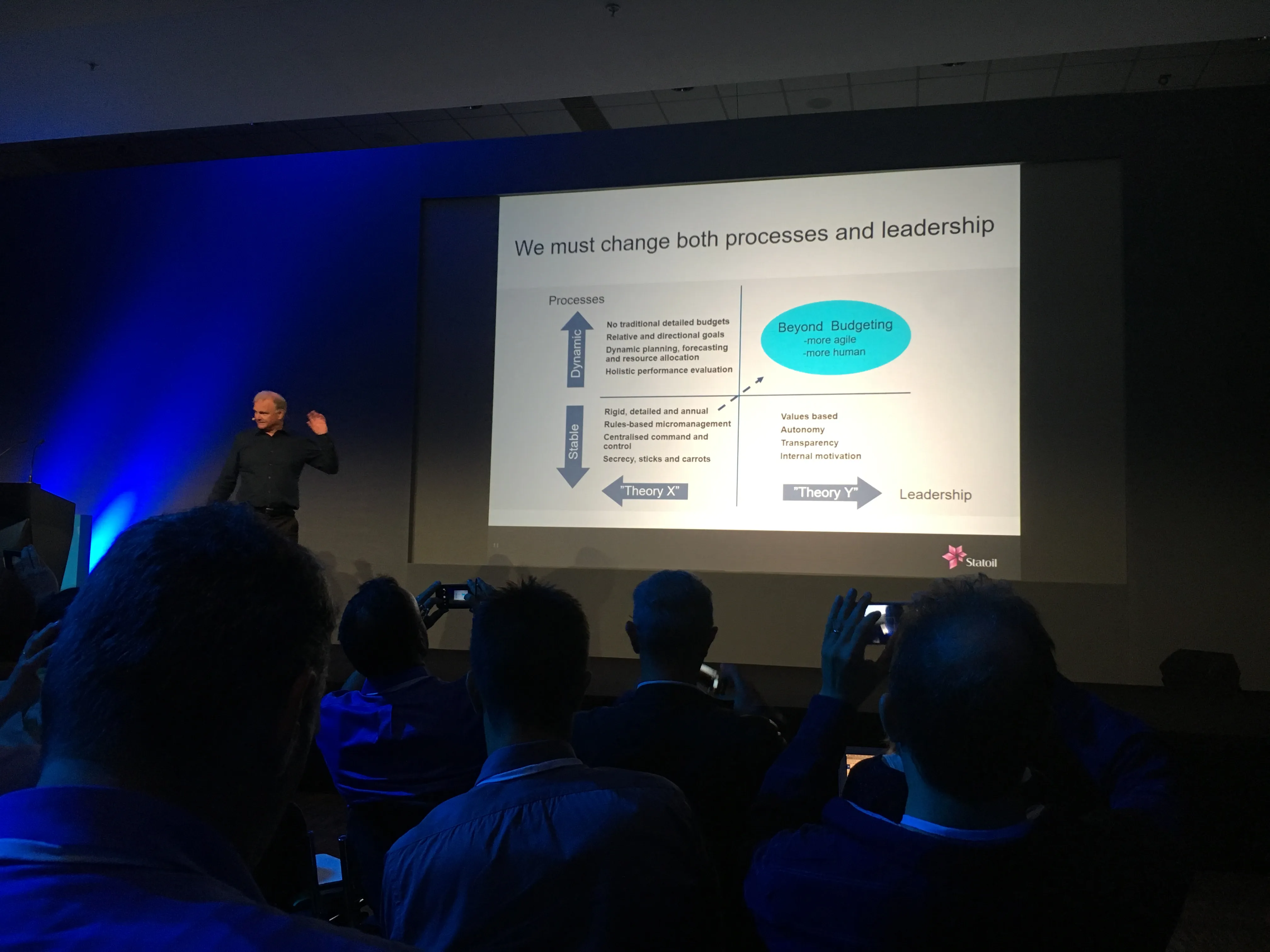
Video link: https://youtu.be/NwqG5W9b37o?list=PLyzb9DL11tdZbjRpEDyP4s1pQsxeFg6x2
My notes: Big companies are rigid, small teams are agile. Can we be big and small at the same time? Maybe through management, but Traditional management is broken. The solution : Beyond Budgeting.
Technology innovation is seen as great, but management innovation is seen as scary in the enterprise. Budgeting creates an illusion of control, forces to make decisions early, is very time consuming, gets outdated quickly, is bad to evaluate performance. It’s all about performance.
Take traffic lights for instance. They are controlled by programmers who are not there anymore, based on initial observations. They can’t adapt to new traffic conditions. Alternative: the roundabout, where we the drivers are in control. Which is the most efficient, which is the most difficult ? In which are the values the most important? Trust, transparency, self-regulation are the values of the roundabout.
What motivates people ? Theory X and Theory Y models mostly positive and negative motivations
A budget is both a target, a forecast, and a tool for resource allocation. One number for 3 conflicting things. Then separate them ! And improve them one by one.
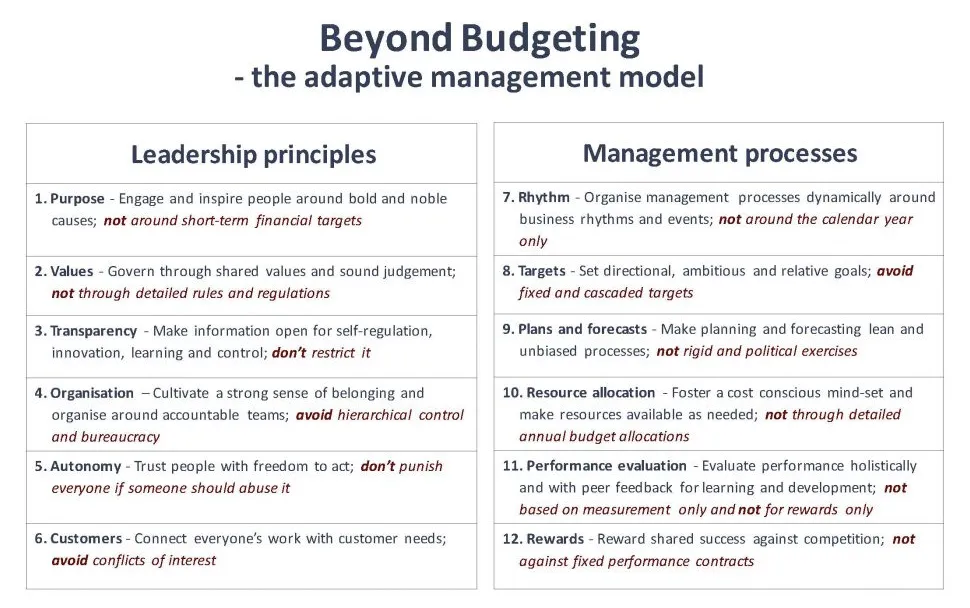
Beyond Budgeting introduces a concept called ambitions and actions, somehow similar to OKR. But they are not cascaded top down by managers. Instead, teams do “translation”: each team discusses how they can do to translate higher goals - without their managers. And they can be revised at any time. You must inform your peers. No artificial deadlines (December). Sometimes no deadlines, sometimes 3 months, 1 year.
Holistic performance evaluations. We can’t base performance evaluations on KPIs. Instead, measure behavior.
Megatrends, by Mark Esposito
Categories: Prospective, Innovation, Greater Good
My take: It’s great to see an innovator think not only about Silicon Valley, but about the entire world. It’s also great to be comforted by these megatrends, but that also means that I’m already convinced. The missing part is: how to go from global findings to local innovations? “Follow the pain points” is not specific enough. And Mark seems to believe that business is the solution to all evils, which I don’t agree with. Overall, a good talk, and a great speaker. I had already seen him the past year, and he’s still a pleasure to listen.
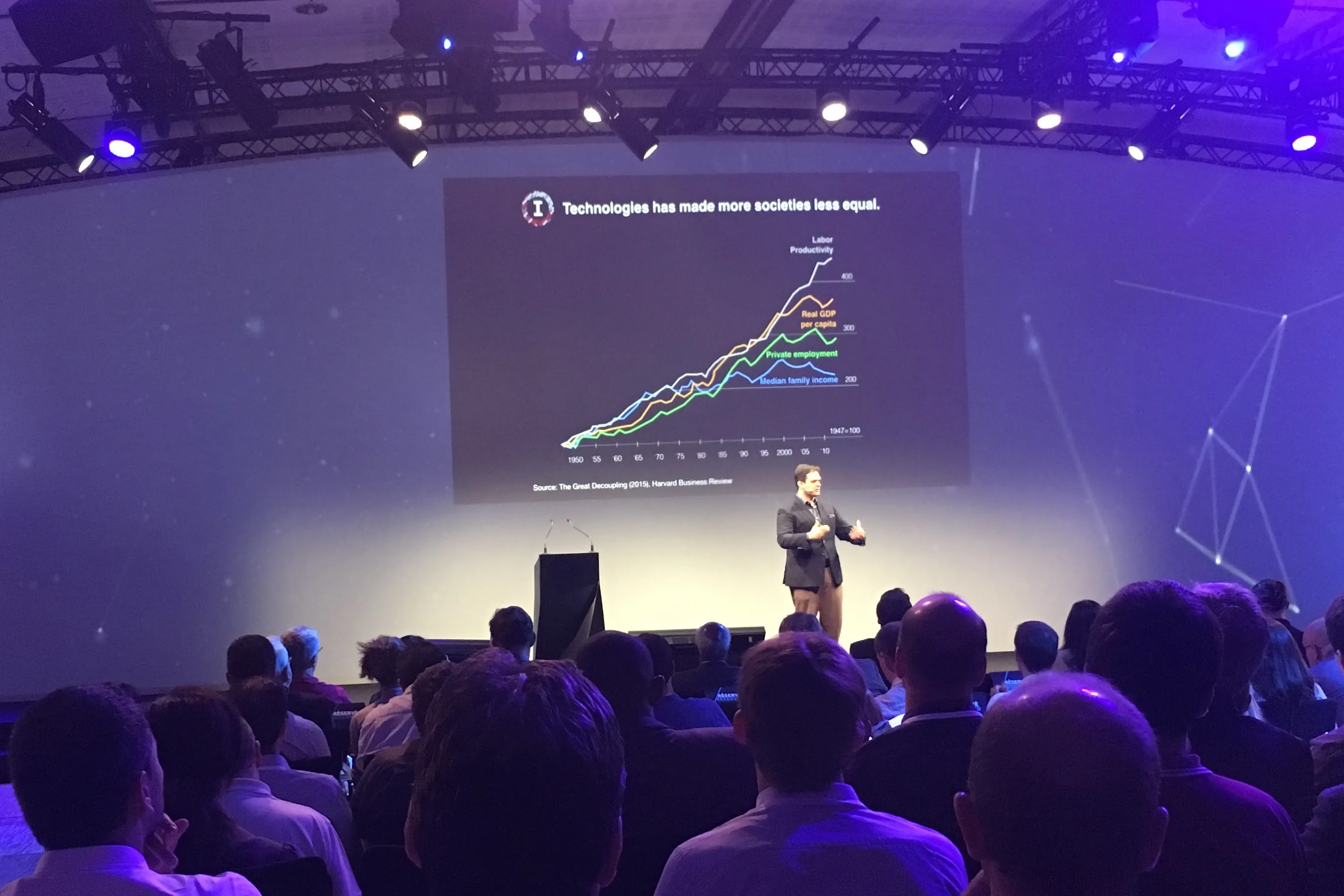
Video link: https://youtu.be/DIq3oN_undI?list=PLyzb9DL11tdZbjRpEDyP4s1pQsxeFg6x2
My notes: We’re obsessed with growth, aggregation. But this can’t last forever. Where does that lead us? To identify the trajectory of our society, we interviewed CEOs. The result is a framework we call DRIVE, listing 5 trends.
D is for demographic and social change. We live older, but there are huge gaps between countries and classes. Aging happens everywhere. Social welfare isn’t sized for that. Kids are no longer the most of the population. We can’t use data from the past as a rule. Some countries are getting older than others : Japan, Germany, Spain, Italy. So we can’t continue business as usual. We must outsmart our predictions. Urbanization brings new challenges : wastes, security, traffic, energy, access to resources. Renewable energy is a great news. But environmental crisis is ahead
R is for resource scarcity. We’re no longer in an age of abundance. Water is the #1 scarce resource. Many places will become less habitable with global warming. We need 25% more water as of 2050, but we don’t have it. So we need to change water supply.
I is for inequalities. The gaps are growing. Digitalization has increased corporate profit, not GDP. We’ve decoupled productivity from wages since 1995. Free market will not work anymore, because it doesn’t yield the traditional results. Life expectancy shows inequalities. Most medical breakthrough is reserved to the richest.
V is for volatility, scale complexity. A new way of thinking that emerges. We are more connected than ever before. The world is an integrated environment. Algorithms and robotics redefine jobs. There will be new jobs, but they won’t require as many people as before. AI will create new jobs, but only in the long term. Most of our predictions are wrong. Statistics provide bad forecasts. Because the spectrum is constantly shifting. AI is getting more and more intelligent. We should make it what we want it to be, i.e. Make AI build a better world. We empower ourselves by understanding the current trends. E for Enterprise Dynamics. Innovation comes from other people, other countries. We can learn from innovation coming from developing countries. There are 4 types of innovation : customer driven, efficiency driven, engineering based, and science based. Efficiency driven is the most world changing, and China is leading in that field.
Opportunities. How do I use these trends into my life, and trigger change ? Which trend matters the most to me? Find field witnesses, people speaking about actual pain points around us. Every pain point is a dormant demand. We can make it a business model. This allows us to think on the micro level. Find your impact and your opportunities. Business has the ability to impact the world. If you don’t like a trend, bring it down to your level, and fix it.
We cannot share our experience with our kids. We have to teach them that volatility is a reality.
Accelerate digital transformation, by Eddie Obeng
Categories: Innovation
My take: Very funny, very innovative in the format, but also quite shallow. I wish Eddie had a plan or took the time to summarize, because without it the talk felt like random thoughts of variable value. As you can see in my notes, I can’t say I learned anything. But this was entertaining.
X might track you and we would rather have your consent before loading this tweet.
Video link: https://youtu.be/ZXLcNSOVMN0?list=PLyzb9DL11tdZbjRpEDyP4s1pQsxeFg6x2
My notes: How do I transform my life with technology? He shows a virtual classroom with other people attending from abroad (kind of like Second Life). That’s a product he created to give trainings across the world without taking the plane. So we can be creative with digital (like VR). He uses a tablet to note suggestions by the audience about what the session should and shouldn’t be about. His notes are hard to read.
There is too much noise about innovation. Predictions about the future emphasize technology, not people. But we are the heroes. Visions of the future are dehumanizing.
Complexity is increasing faster than the world changes. We can’t push information fast enough to hierarchy so that they make the right decisions. Many organizations have an efficiency mindset. They assume that the game is to get rid of people. Their mistake is to try to reduce the cost. But technology should try to enhance people, not replace them.
Some companies spend their times buying stuff. But the model doesn’t change, and the behavior doesn’t change either. They should reconsider their business model. Some companies understand the need to change, but they miss the point (ex: pizza delivery by drone - never gonna happen, teenagers will hijack them). Instead, look for obnoxious customers, who ask things you don’t have - but can pay for it.
Transformation is like caterpillar to butterfly. Huge change. Do not scare people about transformation, or they will be scared and try to protect. Instead, start from where they are. No fear = brains on. Follow-up with a question. What can we do that we’re not currently doing ?
Give Work, by Leila Janah
Categories: Greater Good
My take: A zoom on an initiative which is great, but that very few people can replicate - not many lessons to take away. Apart from that, it’s a nice advertisement for a charity that we can help by subcontracting work instead of giving money. A bit long.
Video link: https://youtu.be/4zY2UgYxBBg?list=PLyzb9DL11tdZbjRpEDyP4s1pQsxeFg6x2
My notes: Our world is better than ever, except for global warming and global poverty. Poverty is the root cause of all problems of developing countries. Our usual reaction is charity. We give money to charities. This funds the aid industry. But poverty isn’t regressing. This translates to a massive waste of time and money.
X might track you and we would rather have your consent before loading this tweet.
The only way to end poverty is to contribute work. When people earn wages, they pay taxes, and the government become accountable. Fiber optic is progressively added to Africa. The digital economy allows people to do work for around the world, they are not condemned by living in a slum anymore.
Leila created Sama Source, teaching people to use digital tools. Work happens in computer centers, in cities and rural. 9000 workers. We’re injecting money at the bottom. It’s called impact sourcing. They stay longer and are more motivated than in developed countries, so they are cheaper. Example tasks: tagging images for computer vision training.
Ready for change, by Aaron Dignan
Categories: Change Management, Leadership
My take: Clear and actionable, I liked the talk. It’s worth watching, because it’s well planned, well executed, and Aaron is a great speaker. It’s the kind of talk that produces simple messages that you want to pin on the wall.
X might track you and we would rather have your consent before loading this tweet.
Video link: https://youtu.be/mFJfGzakM_g?list=PLyzb9DL11tdZbjRpEDyP4s1pQsxeFg6x2
My notes: Hierarchy hasn’t changed for the past 200 years. But engagement is going down. This isn’t a people problem, it’s an OS problem. The basic rules on which the company is built. We need to redefine the OS : information, authority, governance, etc. When you do that exercise (writing down these principles for your company), it helps converging to a common culture. Write your own job description.
But why is change so hard ? Everyone wants change, nobody wants to change. People think of change as loss, as death. We go through the same phases as for grief. Denial, shock, depression, etc. Many models exist in business books. Ex: Change Framework (John Kotter), theory U. Not as simple. A team is made of humans, that don’t fit a linear framework. Also, these models are not useful. In reality, the job comes in the way of change. We’ve learned to shift from static to dynamic, but there is no map for the journey.
5 new principles for change
- control => participation: Teams in a room engage and reflect on how they work. Retrospective.
- planning => experiencing. Example: do a check in at the beginning of meetings. It brings context and energy. You won’t know until you try. Example: rather than teach kids to ride a bike using a 4 wheels bike, give them a 2 wheels bike without pedals. You don’t know how it feels until you do it. Default your organization by letting people do things
- Big changes => small changes. It’s hard to make big changes. Most transformations don’t work. Many small moves give sense of what’s possible. It’s practical, it has a infection effect. Less processes, easier to diagnose. That means limit the size of teams (max 5-7 people).
- Adding => subtracting. When we add things, we also add debt. Often at the beginning, the easiest thing to do to add momentum is to take some things away. Example: remove all meetings off the calendar for 2 weeks. Get the benefit of a white piece of paper. When removing too much, people realize what they really miss, and re-add meetings, but more productive.
- Resistance => Information: “Don’t they see that we should change?” Yes they do, but it’s your fault if you don’t manage to make them change. See their resistance as positive feedback to improve your strategy. People are generally thinking in the right direction. Sometimes participation is enough (when the change goes through people, not thanks to people).
The transformation loop: irritate the system over and over until it reacts. Just like with lean change management. The goal is not to be done. You’re never done. Aim continuous participatory change.
The simulated world our brain generates for us, by Moran Cerf
Categories: Prospective, Cybernetics
My take: Moran is convinced that the Six Billion Dollar Man is just around the corner, he shows recent experiments that prove it. Yet I find it hard to believe, and creepy. Moran sounds like a prophet, but you must be a believer to appreciate the talk, otherwise the guy sounds like he’s crazy. It’s not science, it’s faith. For me, it reminded me about the transhumanists, who blindly venerate the power of technology, lacking any ethical perspective.
Update: On the subject of Brain-Machine Interfaces (BMI), Tim Urban’s loooooooong article on the subject is a must read. You’ll learn much more than by watching Moran Cerf’s talk, but you need a day for it.
X might track you and we would rather have your consent before loading this tweet.
Video link: https://youtu.be/opSn0pv-PYM?list=PLyzb9DL11tdZbjRpEDyP4s1pQsxeFg6x2
My notes: Where neuroscience is standing right now? How different can we be from our ancestors? Human 2.0.
We’re missing one part : plugging prosthesis to the brain. If we manage to do it, it will feel natural. The brain speaks a kind of code that sounds like ticks. We assume that if we plug something that speaks the language of the brain to the brain, the brain will learn to control it. Neuroscientists have been trying that for the past years. But when you think about it, that’s how the brain learns when we are babies. We learn how to see colors from information from our eyes. Our brain is good at that : finding patterns, connecting concepts.
Example experiment: a third arm for a drum player, without plugging inside the brain, just by listening to electrical information on the skull. Next step: putting chips inside people’s heads. Example application: telepathy (communication faster than speak). If we do this, we’ll feel like it comes from our body. Thinking outsourced to the chip will actually feel like our own. It might be the same for feelings. They are sometimes biased. We could correct our feelings. It can make us reasonable and let us sleep at night because it’s the right thing to do. But as a consequence, don’t believe everything you think - it can come from the program.
The complete version of you is limited by your body. If we expend our machinery, we can extend how we think about it. Ex : a prosthetic hand that rotates 360° - the bearer can think about movements that are impossible for us. Plastic surgeons do that all the time, and patients see their new body as the actual body. Imagine if we could plug senses that animals have to our bodies (e.g. see at night like a bat).
We lived in a cave until now. The cave is in our head. The world is a lot more than what we can see. It’s not science fiction. We can already download memory, have brain to brain communication, cure deafness. More than 100 people have chips in their brain to slow down Alzheimer’s. VR is a good first step to train our brain to go beyond reality.
If we can cure blindness, we become gods. That’s what we’re playing at right now. It’s like the mutations that occur with evolution, except we replace chance by intelligent design.
How about our perception of consciousness then? Neuroscientists haven’t found it. You can take parts of the brains out, it’s still there. Maybe it’s just the sum of all parts. In that case, enhanced brains will bring to enhanced consciousness.
Q: A funny question is about the risk of having your brain hacked. Q: about aging. He says: as we live older, we’ll want our brain to think straight, that’s what drives research right now. Q: about Matrix: no, it’s not possible to learn in an instant, but we can accelerate learning by using our brains processing power when we sleep.
The Future of Machine Intelligence, by Nick Bostrom
Categories: Prospective, AI
My take: A good introduction to the state of Artificial Intelligence, the recent progress due to deep learning, and the future implications of the advent of a superintelligence. Despite being a reference in the field of AI, I felt that Nick’s talk lagged behind in terms of impact compared to an article by Tim Urban called The AI Revolution: Our Immortality or Extinction, which I highly recommend. Wait, did I mention Tim Urban again? And it’s not finished.
X might track you and we would rather have your consent before loading this tweet.
Video link: https://youtu.be/8xwESiI6uKA?list=PLyzb9DL11tdZbjRpEDyP4s1pQsxeFg6x2
My notes: The talk exposes the work of scientists about how technology can change the human condition. Until now, no apparent change to the rules of the game. Previous revolutions : Agriculture, Industry. AI could change the human condition just like them.
What is AI ? Not expert systems coded based on the knowledge of experts. These systems didn’t scale to more general forms of intelligence. We now have AI that can describe an image, or create hallucinations, new pictures, style transfer. These can’t be described by a set of rules. We can even generate videos: a horse turned into a zebra, or dreamed videos of beach. AIs can learn to play video games. Using reinforcement learning. Musical imagination. Current research: generalization (learning from 1 or 2 examples). Lots of excitement and progress in AI in general. There was a similar episode of excitement in the past, but expectations weren’t met. Will this wave be similar and shall we face a setback ? Probably not this time: the technology is now good enough. Also, advances in hardware (specialized processing units). Note that the current wave really started when algorithms were run on GPUS.
We still lack a lot to reach general artificial intelligence : transfer learning, reasoning, etc. No consensus yet on when this may happen. But the median from expert projections says there is a 50% probability that it happens within 50 years. But they mostly all agree that this will happen over the course of our lifetime. What are the likely outcomes of general AI ? See how Alphago went from good to superhuman in the course of 6 months. When we reach general AI, it will create a super intelligence. This will create a radical discontinuity in the history of life.
Short term Issues: Self-driving car having to determine who to kill in an accident, fake news, filter bubbles, killer robots, labor market impacts, privacy issues, etc. But we’ll learn to live with AI as we learned to live with cell phones.
Long term issues: how can you control something smarter than you are? Just like king Midas, who got the power to turn everything he touched into gold. Smart idea, but then he couldn’t eat anymore. Example: A paper clip AI could kill everybody to continue making paper clips. There is no connection between the level of intelligence and the sense of purpose or morality. This creates the concern of misspecification. We need to build a scalable control system that resists when the ai reaches ASI. The AI governance problem. A few papers on the subject.
Deep future issues: what shall we do when the AI does everything for us? If it turns well…
Free Beer and Other Secrets of Human Motivation, Dan Ariely
Categories: Leadership, Change Management
My take: Simple message but great moment. The demonstration was crystal clear, progressive, impactful, and funny. Dan is a tremendous speaker. I love how he uses lots of examples to illustrate and fix the ideas. If I had to express one concern, it’s just that I was missing a bit of science to support the advice.
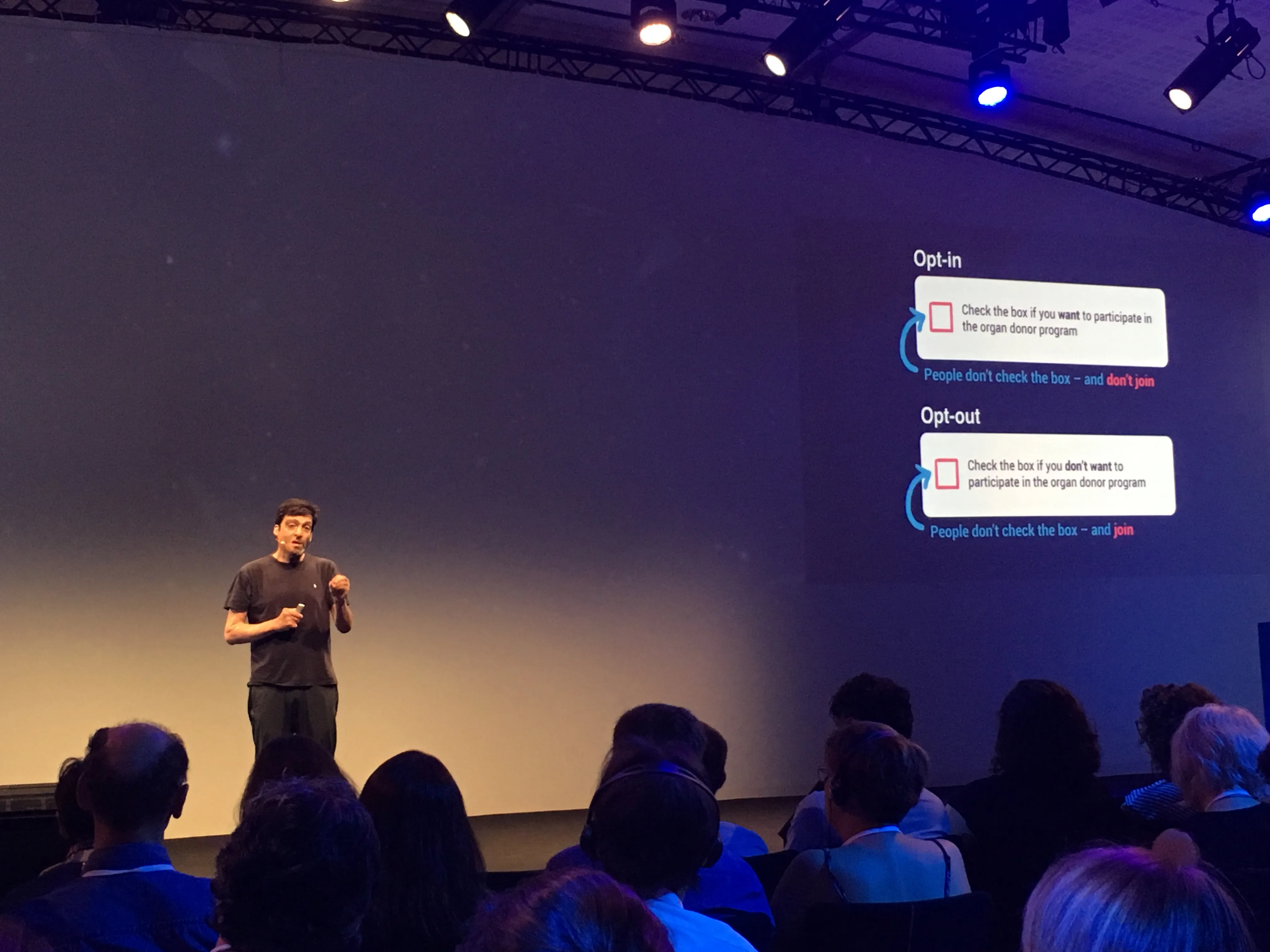
My notes: How do we get people to make decisions? Usually, we think that providing information is enough (that’s the economy theory). But it’s not true. Usually, we know the right thing to do (e.g. Not texting while driving) but it doesn’t matter, we do otherwise. Smoking decreases, but because of taxes, and “second-hand smoke” that makes smokers look like killers, not because we say cigarettes kill the smoker. Information is never enough.
There are other ways. Ex: 100% organ donors in France. Not because of information. But because the checkbox with the license registration is labeled differently: “check the box if you don’t want to participate”. That’s opt out. That’s because when we face hard decisions, we leave it to the person who designed the decision. We’re better at making up stories after making our decisions to justify ourselves. We’re so good at that that we somehow lie to ourselves.
Even giving away something for free isn’t enough. E.g. People don’t accept switching medication to generics for free after using branded medication. That’s a choice between branded and generics AND a choice between doing nothing and doing something. Dan speaks about a medical company who switched the “no action” to “if you don’t choose, your medication will end”. So now patients had only one choice, with the same amount of effort. It worked. “People hate sending letters”, not generics.
Untapped demand: frictions, defaults, are barriers to expressing our preferences. Revealed preferences: people want what they do. For most choices, we don’t really care.
So how can we use that to our benefit and push decisions the right way? A metaphor for life using hackers. Start by mapping how people are making decisions. Analyze the system and find a breach. Think yourself as a choice architect. Here are some examples. To force men to pee inside toilets, paint a small aim inside the toilets. Help poor people save money for the future by letting people text money to a savings account. But to take it out, they had to go to the bank. Easy in, hard out. So the money could just be used in case of emergency. Improvement idea: give an object back to turn something virtual (saving) into something tangible. Giving a coin without value to encourage saving makes invisible visible.
Our goals don’t lead to actions. What we end up doing depends on the environment. There is a gap between goals and actions. (By the way, focus groups are useless). Look for barriers preventing better behavior. Paternalism is good: take the responsibility, make the choices for your customers. And experiment !
Q: Trump election: it was not a vote for Trump, but against the system. Or a vote for the one thing people care about (guns, abortion). Q: Risk of manipulation Q: We appreciate things that demand effort. And we overestimate our own efforts, and underestimate the efforts of others.
Einstein ou l’art de dépasser les limites du monde, par Etienne Klein
Categories: Philosophy, Innovation
My take: Inspiring talk, easy to transpose to everyday life: take some time off, question your reality, don’t wait to have all the tools. Etienne is a natural born storyteller, and tells memorable stories. As usual with philosophers, no need for slides.
X might track you and we would rather have your consent before loading this tweet.
Video link: https://youtu.be/1y34Obv3OVo?list=PLyzb9DL11tdZbjRpEDyP4s1pQsxeFg6x2
My notes (in French because the conference was in French ; also, I missed the start): Einstein laisse les idées lui venir. Il a conçu la relativité alors qu’il n’était pas physicien. Il n’invente rien.
Il se met en situation et comprend, à partir des équations de Newton, des effets inattendus de la gravitation. Il formule que c’est la même chose qu’une accélération. Il fait des expériences de pensée (comme aller dans un lieu de l’espace où la gravité n’existe pas). Comme il n’y a pas d’expérience qui permette de distinguer entre la gravité et une accélération constante, c’est la même chose.
Et si je suis dans une cabine accélérée, qu’un rayon de lumière entre (à vitesse constante), je verrai la lumière heurter la paroi opposée plus bas qu’elle n’est entrée. Et comme c’est pareil sur la terre, alors la gravitation doit dévier la lumière. Pour valider cette hypothèse, il attend une éclipse totale du soleil pour voir si le soleil dévie la lumière des étoiles derrière. Il n’arrive pas à faire cette mesure (c’est la guerre), heureusement car à cette époque ses équations sont fausses.
Il comprend qu’il doit utiliser les géométries non euclidiennes - celles d’un espace temps courbe. Il les connaît mal - il est mauvais en maths. L’idée est que la gravitation n’est pas une force, mais une déformation de l’espace-temps. Les corps qui subissent la gravitation ne subissent pas de force, donc ils vont en ligne droite. Si on voit des trajectoires courbées, c’est que l’espace est courbé.
Bien sûr, il y a des maths complexes derrière. Mais le génie d’Einstein est de poser des questions sans faire d’impasse. Et si la réponse donne une nouvelle question, répondre à cette nouvelle question.
Hack the Future, by Keren Elazary
Categories: Security
My take: Great conference for security noobs, and to demystify the hacker. But if you read hacker news regularly, you won’t learn much. A good mix of FUD and hope. It’s even accessible to non-IT people, so worth showing to your friends and family. Encouraging people to learn code and to welcome geeks can only make the world a better place!
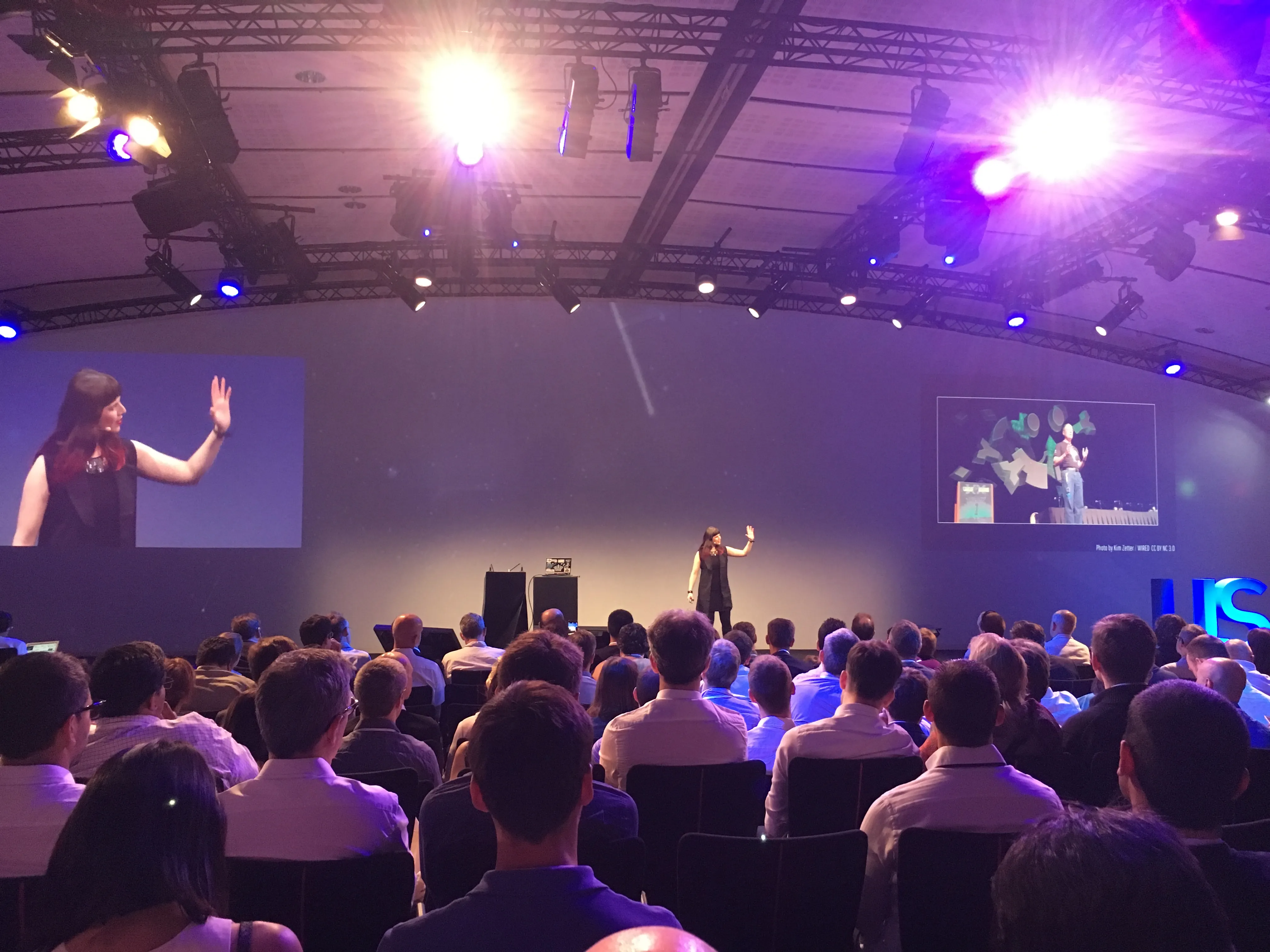
Video link: https://youtu.be/uhJYZM2_U-0?list=PLyzb9DL11tdZbjRpEDyP4s1pQsxeFg6x2
My notes: Hackers already try to influence elections and politics. One Hacker has confessed influencing elections in Latin America, e.g. using an army of Twitter robots. Hackers have a huge power, and they innovate. World leaders realized they can harness the power of hackers. We could all learn from their power, too.
We are afraid that hackers could start a nuclear war. But they could also stop a nuclear war. E.g. Stuxnet disrupted Iranian nuclear enrichment centers. The whole world realized the disruptive power of code. We’ll see the good and bad side today.
There are many hackers trying to make the world a better place. Like Barnaby Jack, who hacked ATMs and also insulin pumps, but revealed the hack to the manufacturers. This lead to a regulation change for medical devices. Like Mary Mo. She had a pacemaker after surgery, without her consent. Now she’s actively asking hackers to try and hack her heart, to make the device more secure. Like Jay Radcliffe, who discovered a vulnerability in an insulin pump - without anybody being harmed in the process.
Me and other hackers are are member of a group called “I am the cavalry”. Like Craig Smith, who is a car hacker. Other car hackers can remotely take control of a Chrysler car. That lead to a massive car recall. The solution in that case: a software update. Using GPS spoofing, you can deviate a Yacht. We’ll soon have to be the CTOs of our lives to prevent breaches.
Tesla has been working actively with hackers. You have to demo a threat to spark a solution. It may be frightening, but hackers force us to contend with reality. They are members of an immune system.
Bug bounty programs : a great way for companies to get collaboration from hackers. See bugcrowd, a crowed source bug bounty program. Even the Pentagon participated in. A vulnerability was found within 30 minutes. Eventually, hackers discovered 200 vulnerabilities in the Pentagon Internet surface. For a few dozen thousand dollars.
IoT will grow, because of data. Our usage data is very valuable - not necessarily for us. See shodan.io, a global map of connected devices. But IoT devices are generally very vulnerable. An entire network of webcams was hacked and used to hack into other devices (because they have access to broadband Internet). It supercharged the Mirai botnet. Just because username and password were obvious. Who’s the real criminal here ?
New trend : Ransomware. Criminals encrypt your files and ask bitcoin. Wanacry shut down Renault factories. This will increase because our data is too important for us. The value of bitcoin doubled after wanacry. So criminals made more money by playing with bitcoin than by ransom.
The vulnerability at the heart of Wanacry came from the NSA. Who’s the real criminal here? The hacker group who leaked the NSA weapons to the public, or the NSA? The hero is the guy who accidentally stopped the spread by registering a domain name.
Many kids go to defcon. They are the future of hacking. I met awesome individuals there. I even saw a hacking competition won by a computer called Mayhem. This marks the next step of cyber security. But hackers are very good at outsmarting machines. This job will persist.
Ok, we’re frightening. But reach out to hackers and you will see what they can do for you. Cyber security is about protecting our way of life.
What you can do to make your life safer: stop (password) recycling. See haveibeenpwnd.com. Share information about security incidents in your work or home. Otherwise, it’s like not being vaccinated. Check the software ingredients of the tools you’re using. Publish a software ingredient list for your software.
Q: How to become a hacker? Learn to code, and go to meetups. Q: What’s the limit ? Usually, physical harm. Q: AI is already a new playground for many hackers.
Redesigning Leadership, by John Maeda
Categories: Leadership, Design
My Take: So many takeaways there, I need to watch it again. My notes don’t give justice to this talk, which was fantastic, and really worth watching. Formally, the talk was chaotic, but John gives so much insight that it doesn’t matter. He’s an awesome speaker, and boy does he know his subject. I would just love to work with such a guy. It’s a pity there were so many questions unrelated to the subject, and that John couldn’t finish his argument.
Video link: https://youtu.be/UR5_G9nxKow?list=PLyzb9DL11tdZbjRpEDyP4s1pQsxeFg6x2
My notes (that don’t make much sense because the talk was so dense): Formal innovation: John asks the audience to ask questions while he speaks, so it’s better being here than watching the talk on YouTube.
Leaders are not always about radical transformation. E.g. If you lead a large company. Presentation plan:
- Moore’s law. Exponential growth. Computers do more for a cheaper price. It means that change happens. Potentially very fast. So deal with it.
- Start-ups all want to become successful, i.e. turn themselves into end-ups
- Design is about inclusion, not beauty. Artists are able to take risks, like entrepreneurs
Let’s start with Moore’s law. People who lived at the beginning of the personal computer era lived through the progress. They have context. But beware: as you get smarter, you also get dumber because you believe in what you have lived through too much. E.g. Seeing that VR didn’t take off 20 years ago doesn’t mean it won’t this time. If you’re the only one good at something, you don’t know if you’re good enough. So I trained students on design. Computers have changed our lives tremendously. Think about email, mobile. User experience matters so much because we are experiencing it so much. A pain point experienced all day long becomes a pain plane. Since we have a high mobile usage, we can’t tolerate the same pain as before with software.
Q: Changing large organizations is easy when most people in the organization are oriented to the outside (towards the world). That means your job is to connect with the world. Discover people who are better than themselves, and that they must compete and innovate.
If your company was founded before 2009, you live in the era of desktop. If you were founded after, you live with customers who want better use experiences, and who use mobile.
Just like cars: improving the user experience (the inside of the car) increases usage. It’s complementary with improving the infrastructure (roads).
Q: How can you learn leadership? Not at school, but through failure. Q: How to learn design? You must be in contact with the customer.
Start-ups vs End-ups (large, durable companies): End-ups have more structure, less chaos than startups.
Designers are not artists. Designers make solutions, artists make questions. Designers look for fit between form and content. Art is about the unknown, mysteries. But you don’t want it for your money or your body. A leader’s job is to balance creativity with safety. Startups spend too much time being creative. End ups spend too much time being safe. Take the next step.
Procrastination, by Tim Urban
Categories: Management
My take: In case it was not apparent from my notes on the BMI and AI talks, I love Tim. Or rather: I’m an absolute fan. He’s a great speaker, and his blog posts on Wait but Why are very profound and enlightening. But this talk suffered from a loss of balance between the first half (very solid and funny) and the second (which, in my opinion, needs more work). So watch Tim’s 15 minutes TED talk on procrastination, and skip the second part of the USI talk.
X might track you and we would rather have your consent before loading this tweet.
My notes: The first half of the talk is exactly the same he gave at TED, so I won’t describe it.
Tim shows Einsenhower’s 4 quadrant prioritizing chart with urgent and important, and shows how procrastinators do differently but manage to actually do work.
Reasoning from first principles vs reasoning by analogy. We do the second most of the time, even though we like to see ourselves as a scientists (who reason from first principles). Great innovators, like Elon Musk, are very first principle.
What we learn is to do things because we were told so. But children have a different reasoning. They want to always know why. We take away that instinct. We constantly refer to bibles that we believe. Think about the difference between a cook (created from recipe) and a chef (created from ingredients). Start playing the why game with yourself. Why are you doing this job, why are you married with that girl ? If the response is always “because I was said so”, reconsider.
Creativity is never on a deadline. It’s important, but not urgent. It’s unfortunately where most of us mess up. We usually manage to do important and urgent things, even procrastinators. It’s just that procrastinators don’t have time to reason from first principles.
Takeaway: think about how you think, challenge it. And consider that life is short.
Agile: Where Are We At?, by Henrik Kniberg
Categories: Agile
My Take: Excellent summary of the state of agile today, well worth watching if you’re just starting on the subject and eager to check that you’re headed in the right direction. My company has been doing agile projects for the past 4 years, we do agile coaching ourselves, so there was nothing new for me in this conference. I was a bit disappointed that the talk didn’t evoke the “Agile is dead” discussions, or emerging trends like Modern Agile and Agile at Scale.
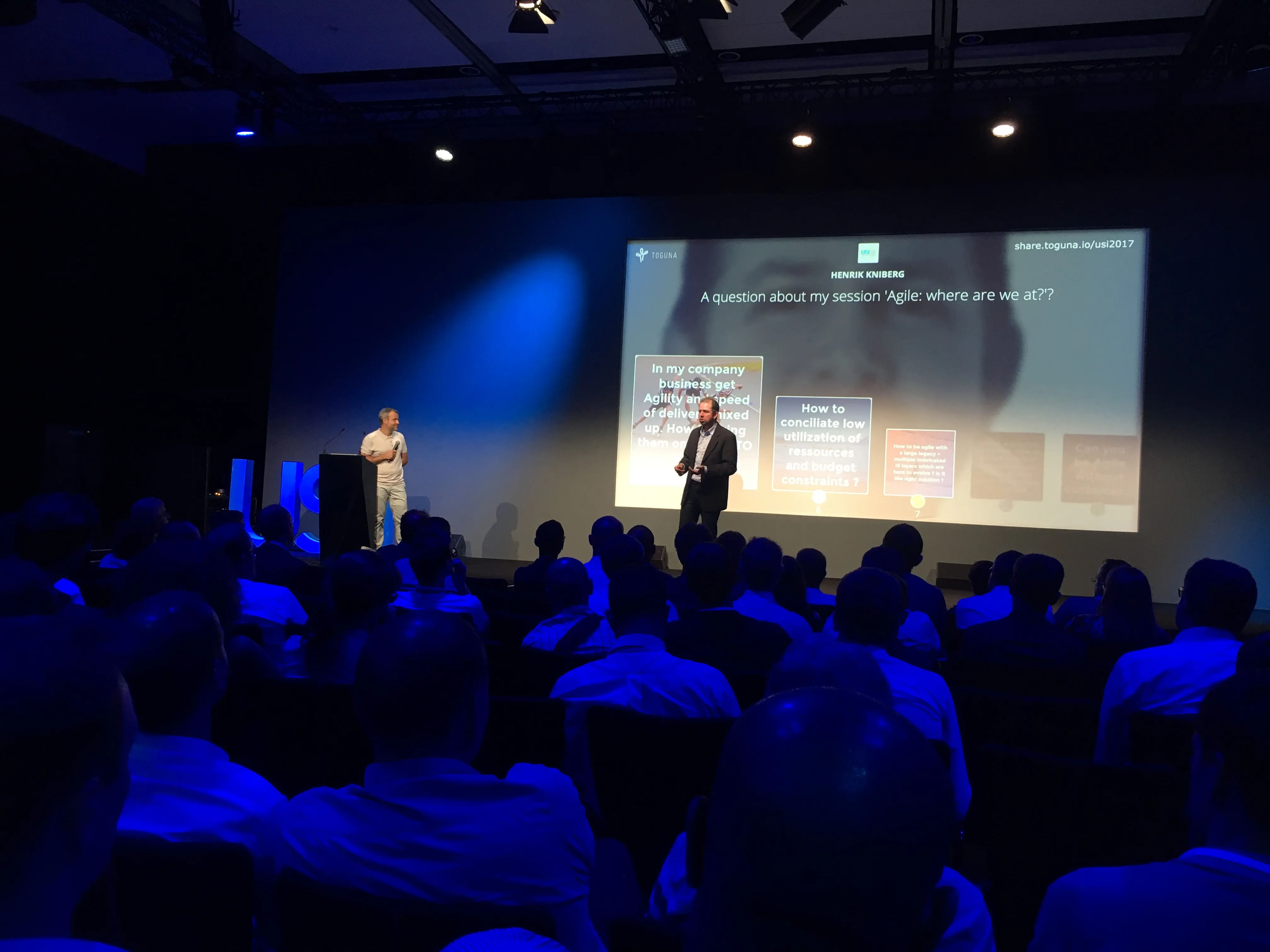
Video link: https://youtu.be/gILDSmm5Pjc?list=PLyzb9DL11tdZbjRpEDyP4s1pQsxeFg6x2
My notes: Agile is spreading: HR, hardware, education… When you want to start, you hear buzzwords like TDD and SCRUM, and it’s hard.
How did I start? As a coder. No matter how good the code was, most projects failed miserably. The common approach: waterfall. Then I ran my own team. I read up and started doing agile. Cross-functional teams, collocated, iterative development, feedback loop. It doesn’t always succeed, but when it fails, it fails faster. I did consultancy, and became an agile coach.
But why is agile working ? All practices come from Lean and Agile principles, which come from Psychology ans system thinking. Most of it comes down to the fact that companies create a lot of waste.
Then Henrik starts a serious game on stage, featuring his own children. The animator pushes a Lego piece, which must be handed over to the customer, across 5 stages (5 volunteers who pass the lego piece to their closest neighbor). The manager pauses the process and sees only one person working. Then he calls the agile coach. The agile coach gives work to everyone in the chain. Then they all get busy, but with zero outcome, and the customer isn’t happy. 100% ressource utilization = no flow. Like a traffic jam. Low utilization, fast flow.
How do we get both ? By pulling. Each one pulls as much as they have capacity. It’s good that someone has nothing to do, so they can pull. Don’t reward people for working hard. Don’t optimize for effort. Instead, reward based on value. And share the sense of value with everybody. What you measure is what you get. Measure effort, you won’t get output. Agile measures output. But it should not be the end. They should focus on value (customer) and learning.
How to scale ? The Spotify history that Henrik wrote. Squads. Tribes. Then it became a model. But seen from the inside, it’s just an example. Why did it make so much impact? Organizations are desperate for change, and they want to get inspired.
Why is agile spreading so fast? Henrik answers using the Cynefin model. He differentiates simple, complicated and complex problems. Agile is good for complex problems. And the world is moving to more complexity.
Predictive process = cannonball. But if the goal moves, it doesn’t work. If the customers don’t know what they want either. Instead, we need a homing missile. Send it early, but let it turn when the goal changes.
State of agile survey: agile has gone mainstream, at least in software. It’s not controversial anymore. And why ? Speed, productivity, and manage changing priorities.
Takeaways: a tool, not a goal. Focus on principles more than practices. Don’t use agile if there is no complexity. Agile is a direction, not a place.
Q: Is agile only for software ? No, see Lego. Agile spread like a virus. Other examples for HR, aeronautics. Simple Kanban even works for 4 years old. And agile is spreading. Q: Is agile a silver bullet ? no. It works better than waterfall for complex systems, that’s all. Q: Is it new? No, agile was old wisdom rediscovered. Agile is just a word. How to recognize the real thing ? Release often, experiment a lot, get customer feedback Q: Next 10 years ? More complexity-> more agile. But it will become mainstream and the name will vanish. It’s a fashion industry, and buzzwords will vanish. In complex environments, not agile companies will die.
La peur, par Ingrid Betancourt
Category: Greater Good
My take: This first-hand narrative about a 6 years captivity in the jungle gives a huge sense of perspective to our little problems. Ingrid made us live her fears, hopes, and faith for 20 memorable minutes. The talk won’t make you a better worker, but it will make you a better person. Go watch it.
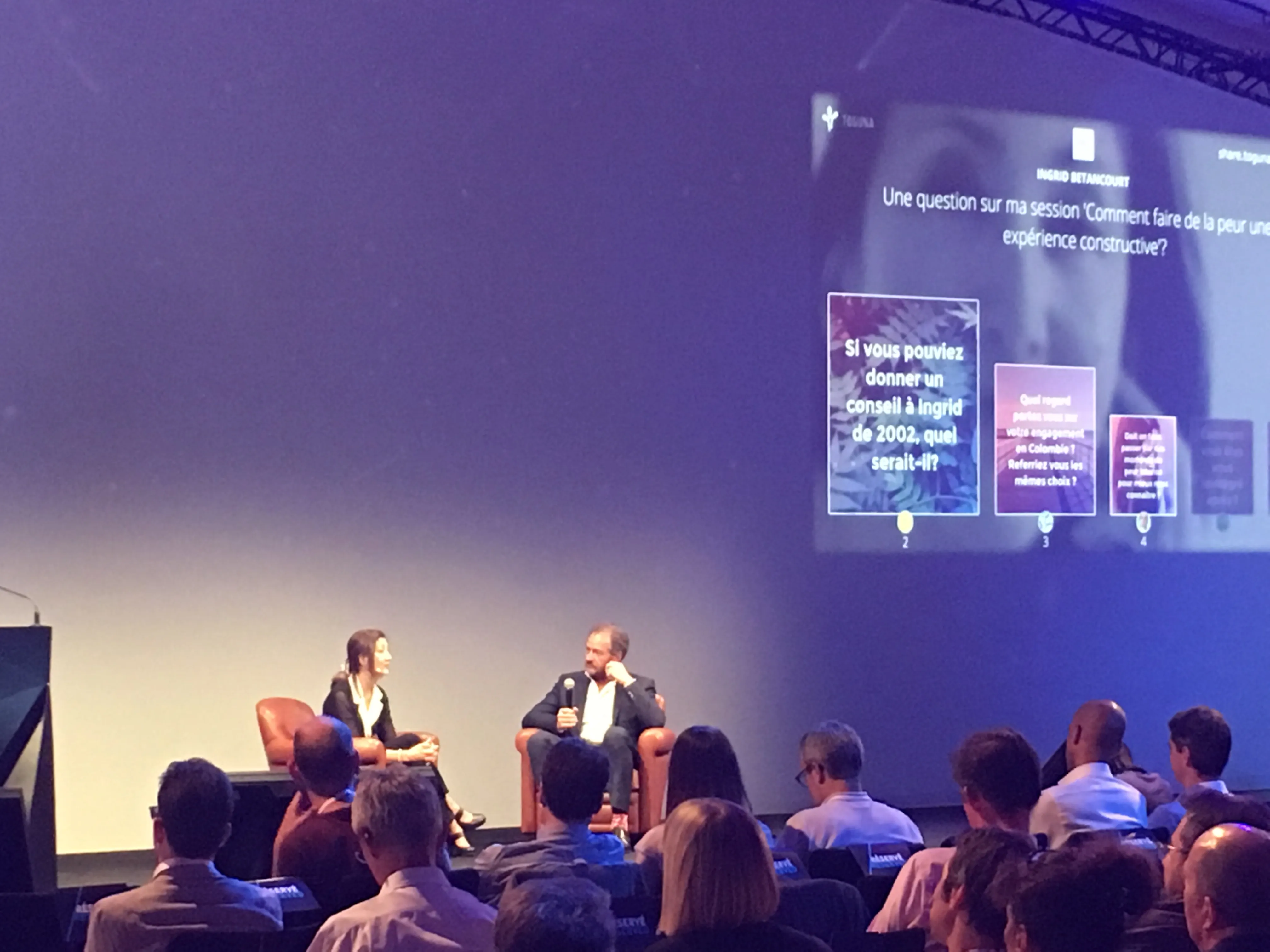
Video link: https://youtu.be/WuXXaGeet-0?list=PLyzb9DL11tdZbjRpEDyP4s1pQsxeFg6x2
My notes (in French because the conference was in French): Ingrid a connu la peur pour la première fois à 41 ans. Retournée en Colombie pour s’engager politique, elle voit la violence monter. Élue sénatrice. Mais elle n’était pas courageuse, juste qu’elle n’avait jamais connu la peur.
Ca a changé le jour de mon enlèvement par un commando des FARC. J’ai été paralysée. J’ai réalisé que ces hommes allaient me tuer. Puis la peur est devenue mon compagnon. La peur à des manifestations physiques très difficiles à supporter et à contrôler. Je me désintégrais. J’agissais par instinct, incapable de réflexion. Je découvrais un autre moi.
La vraie peur est la porte de la connaissance de soi. C’est en ça que ça peut être une expérience fondatrice. On m’a demandé de m’identifier avec un chiffre. Malgré la peur, je ne pouvais accepter de perdre mon identité. Après un an, j’ai réussi à agir non par instinct, mais par principe. À côté de l’instinct de survie, il y a celui de la morale.
La peur créé une sorte d’autisme. J’ai découvert le surpassement par la main tendue de l’autre. La jungle, c’est sombre, moite, dangereux. Mais les animaux nous ont fait moins de mal que les hommes. Les FARC entretenaient un enfer, nous montaient les uns contre les autres. Je me suis enfuie avec un compagnon de captivité. On avait pris la décision de survivre ou de périr ensemble. La peur isole, le seul moyen de surmonter ces instinct, c’est l’autre.
Le troisième moment que je veux partager, c’est la force qu’on a en nous-mêmes. Un des captifs, le plus couard, décide de s’évader. Ingrid l’aide pendant des mois, dans le secret. Et elle lui dit que s’il est perdu, Dieu le soutiendrait. Il réussit à s’évader. Et sa première déclaration à la radio est : Ingrid, j’ai fait ce que tu m’as dit, j’ai appelé Dieu, et il m’a envoyé la patrouille. La peur est contagieuse, mais la foi aussi. La foi nous permet de devenir ce que nous avons choisi d’être.
Depuis la libération, j’ai vu que la peur existe dans le monde libre. Elle est utilisée pour nous manipuler. Brexit, mur du Mexique, terrorisme islamique. Ce qu’on peut faire, c’est refuser que cette peur soit instrumentalisée, avec nos valeurs, notre amour, notre foi. On aura toujours le choix de vivre avec notre peur, ou de nous relever pour être plus humains.
Conclusion
The venue, as usual, was amazing. Watching international speakers with the comfort of the Carrousel du Louvre, the fabulous food, great connectivity, and most important, its powerful air conditioning, was a very pleasant experience.
As for the networking, I must admit that I don’t feel that I belong to the audience. Many people in suits coming from banks, consulting companies, Telcos, and most generally CAC40 companies. Who else can afford the hefty ticket price? During one symptomatic moment, one speaker asked who in the audience worked for a startup. We were only a handful to raise our hand. So I can’t say I’ve met great people and made profitable business connections.
Shall I return there next year? Probably not. USI feels more and more like an Octo-centric conference, and this contributes to my impostor syndrome there. Besides, as I do a lot of research on the subjects of security, AI, lean & agile, innovation, and product development, there were only a few inspirational moments for me during these two days. I didn’t experience what I found there a few years ago - a revelation of the path to follow for the next three years.
Authors

Marmelab founder and CEO, passionate about web technologies, agile, sustainability, leadership, and open-source. Lead developer of react-admin, founder of GreenFrame.io, and regular speaker at tech conferences.